The Evolution, Scope, and Function of Duty of Care in LAWS8702
VerifiedAdded on 2023/06/04
|7
|1963
|385
Essay
AI Summary
This essay provides a comprehensive analysis of the duty of care in tort law, tracing its evolution from its historical roots to its current application in Australian law. The essay begins by examining the early development of negligence and the emergence of the duty of care as a key element. It t...
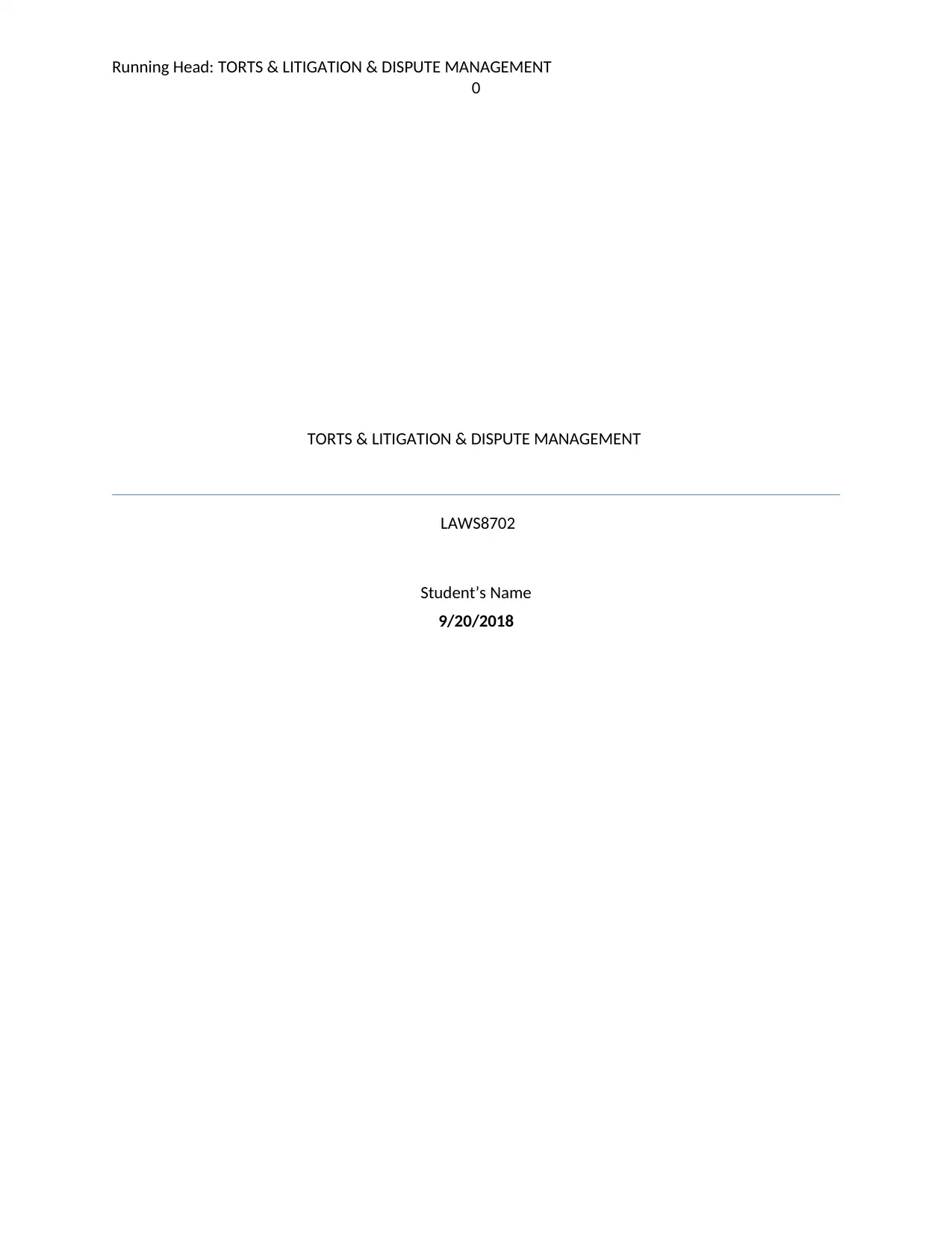
Running Head: TORTS & LITIGATION & DISPUTE MANAGEMENT
0
TORTS & LITIGATION & DISPUTE MANAGEMENT
LAWS8702
Student’s Name
9/20/2018
0
TORTS & LITIGATION & DISPUTE MANAGEMENT
LAWS8702
Student’s Name
9/20/2018
Secure Best Marks with AI Grader
Need help grading? Try our AI Grader for instant feedback on your assignments.
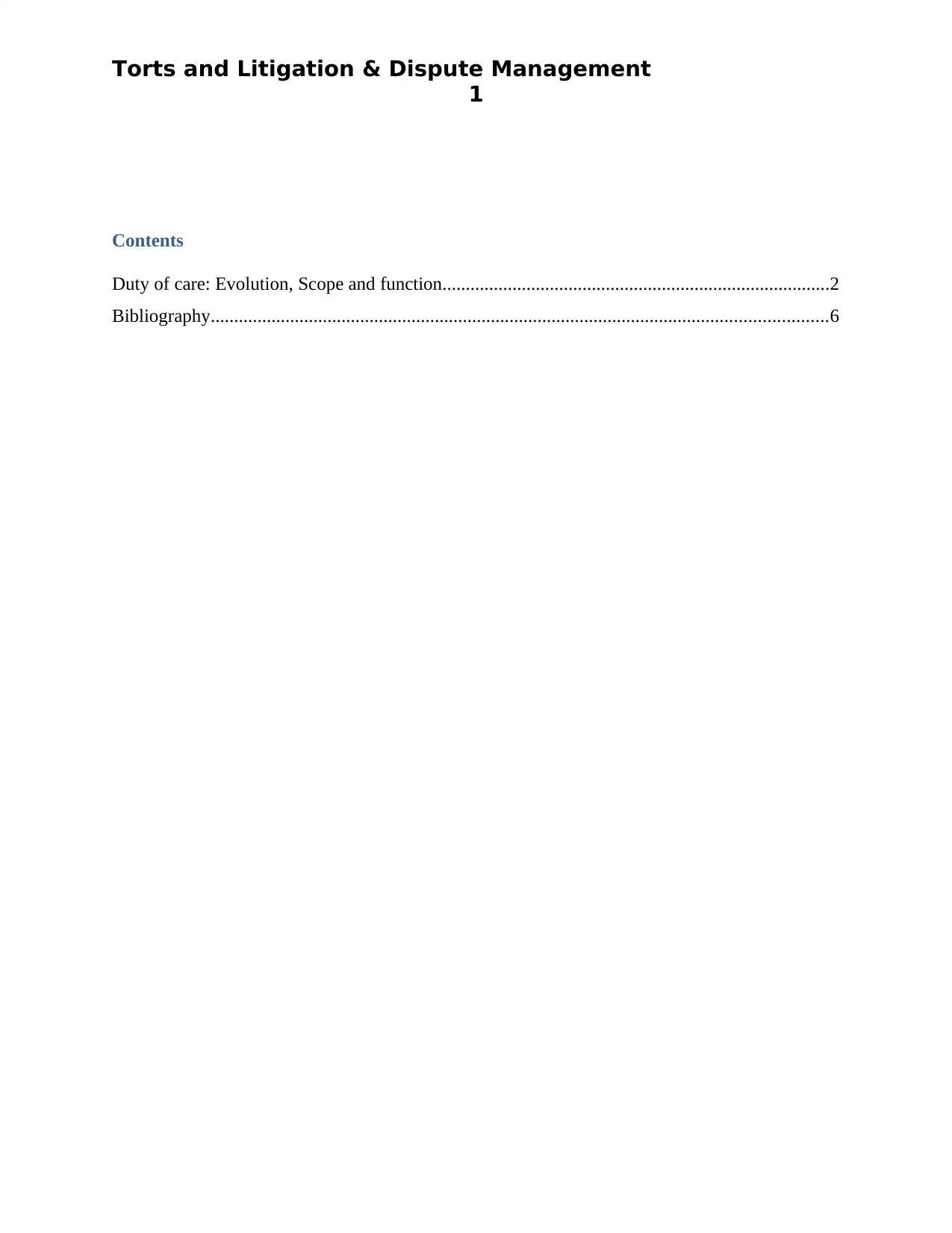
Torts and Litigation & Dispute Management
1
Contents
Duty of care: Evolution, Scope and function...................................................................................2
Bibliography....................................................................................................................................6
1
Contents
Duty of care: Evolution, Scope and function...................................................................................2
Bibliography....................................................................................................................................6
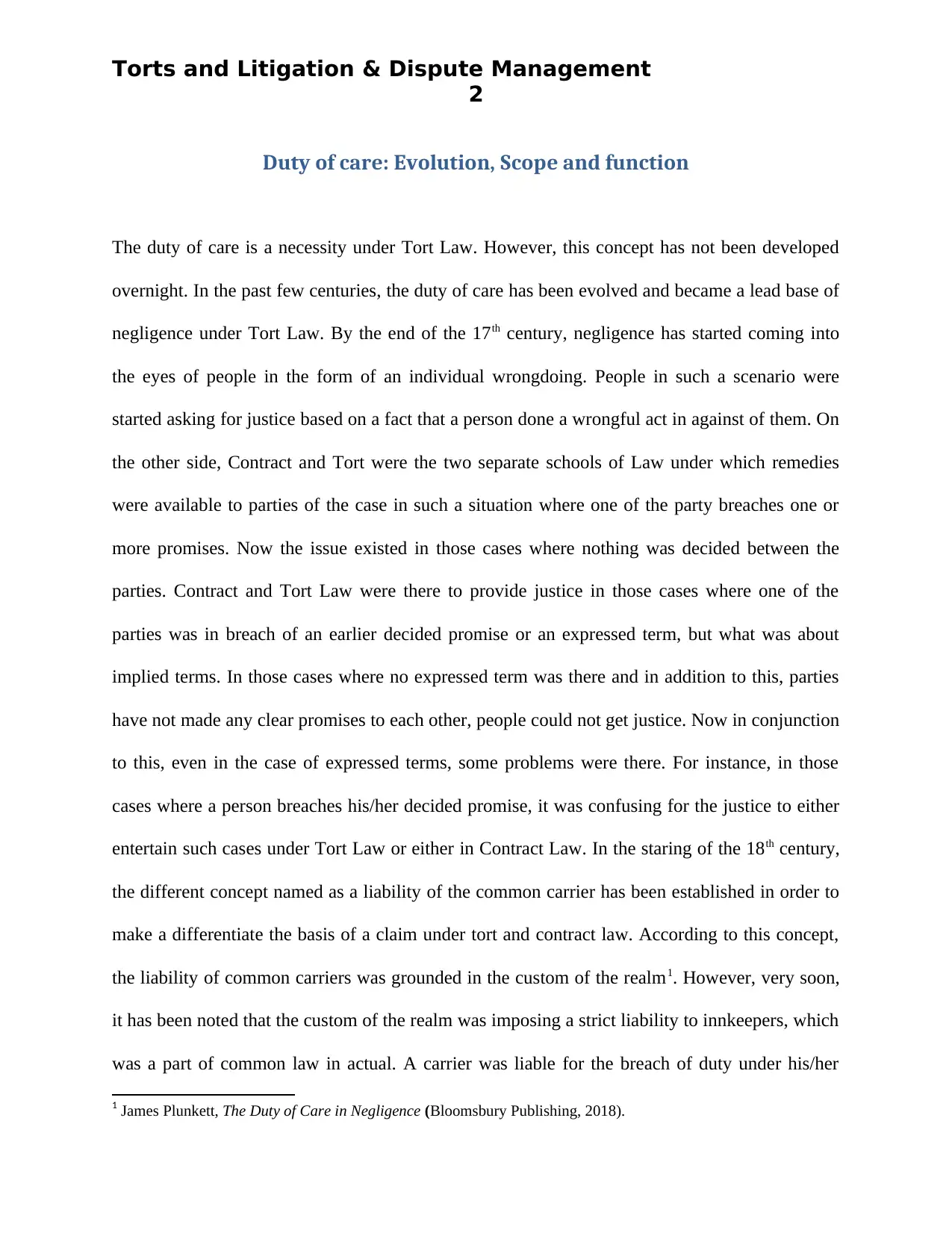
Torts and Litigation & Dispute Management
2
Duty of care: Evolution, Scope and function
The duty of care is a necessity under Tort Law. However, this concept has not been developed
overnight. In the past few centuries, the duty of care has been evolved and became a lead base of
negligence under Tort Law. By the end of the 17th century, negligence has started coming into
the eyes of people in the form of an individual wrongdoing. People in such a scenario were
started asking for justice based on a fact that a person done a wrongful act in against of them. On
the other side, Contract and Tort were the two separate schools of Law under which remedies
were available to parties of the case in such a situation where one of the party breaches one or
more promises. Now the issue existed in those cases where nothing was decided between the
parties. Contract and Tort Law were there to provide justice in those cases where one of the
parties was in breach of an earlier decided promise or an expressed term, but what was about
implied terms. In those cases where no expressed term was there and in addition to this, parties
have not made any clear promises to each other, people could not get justice. Now in conjunction
to this, even in the case of expressed terms, some problems were there. For instance, in those
cases where a person breaches his/her decided promise, it was confusing for the justice to either
entertain such cases under Tort Law or either in Contract Law. In the staring of the 18th century,
the different concept named as a liability of the common carrier has been established in order to
make a differentiate the basis of a claim under tort and contract law. According to this concept,
the liability of common carriers was grounded in the custom of the realm1. However, very soon,
it has been noted that the custom of the realm was imposing a strict liability to innkeepers, which
was a part of common law in actual. A carrier was liable for the breach of duty under his/her
1 James Plunkett, The Duty of Care in Negligence (Bloomsbury Publishing, 2018).
2
Duty of care: Evolution, Scope and function
The duty of care is a necessity under Tort Law. However, this concept has not been developed
overnight. In the past few centuries, the duty of care has been evolved and became a lead base of
negligence under Tort Law. By the end of the 17th century, negligence has started coming into
the eyes of people in the form of an individual wrongdoing. People in such a scenario were
started asking for justice based on a fact that a person done a wrongful act in against of them. On
the other side, Contract and Tort were the two separate schools of Law under which remedies
were available to parties of the case in such a situation where one of the party breaches one or
more promises. Now the issue existed in those cases where nothing was decided between the
parties. Contract and Tort Law were there to provide justice in those cases where one of the
parties was in breach of an earlier decided promise or an expressed term, but what was about
implied terms. In those cases where no expressed term was there and in addition to this, parties
have not made any clear promises to each other, people could not get justice. Now in conjunction
to this, even in the case of expressed terms, some problems were there. For instance, in those
cases where a person breaches his/her decided promise, it was confusing for the justice to either
entertain such cases under Tort Law or either in Contract Law. In the staring of the 18th century,
the different concept named as a liability of the common carrier has been established in order to
make a differentiate the basis of a claim under tort and contract law. According to this concept,
the liability of common carriers was grounded in the custom of the realm1. However, very soon,
it has been noted that the custom of the realm was imposing a strict liability to innkeepers, which
was a part of common law in actual. A carrier was liable for the breach of duty under his/her
1 James Plunkett, The Duty of Care in Negligence (Bloomsbury Publishing, 2018).
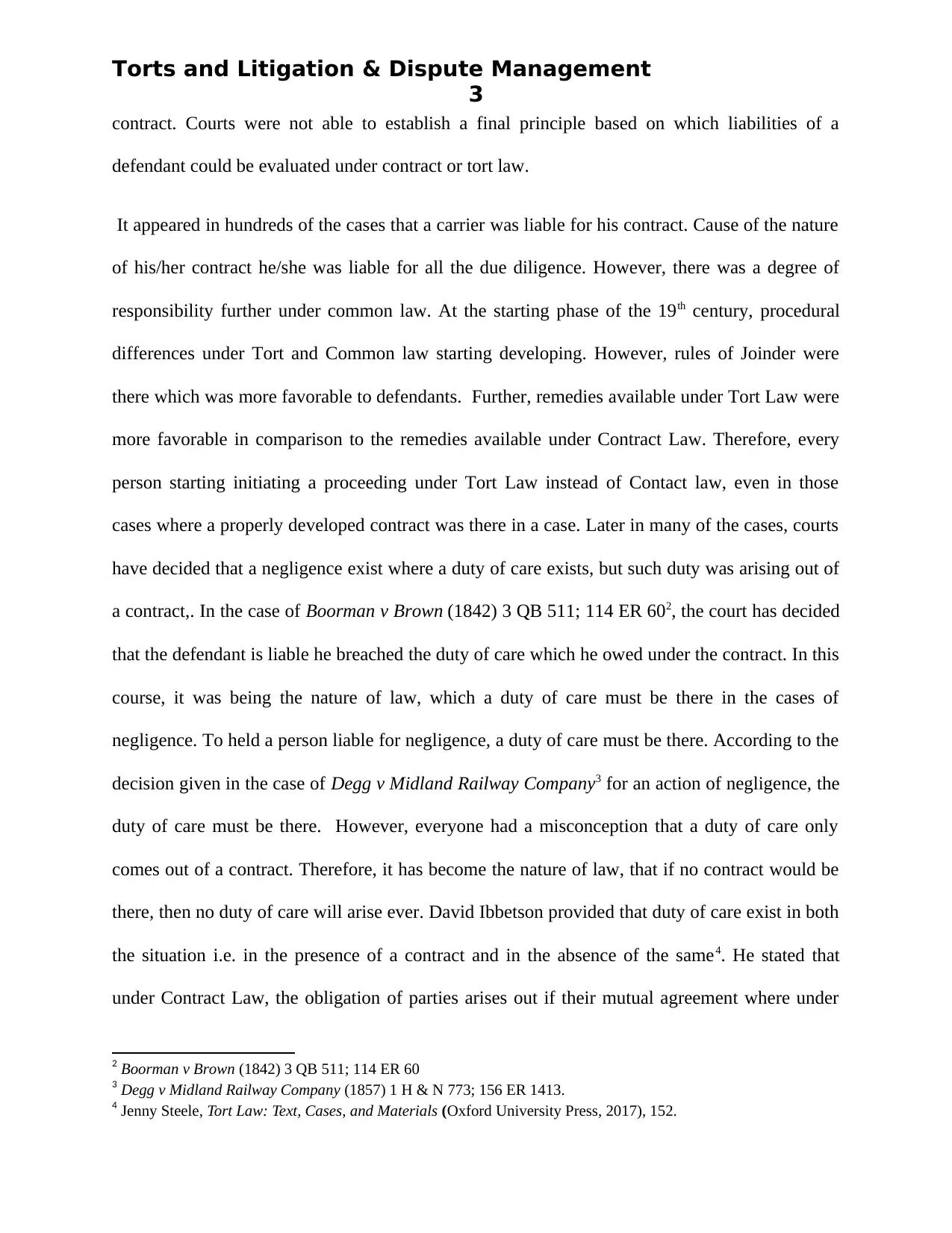
Torts and Litigation & Dispute Management
3
contract. Courts were not able to establish a final principle based on which liabilities of a
defendant could be evaluated under contract or tort law.
It appeared in hundreds of the cases that a carrier was liable for his contract. Cause of the nature
of his/her contract he/she was liable for all the due diligence. However, there was a degree of
responsibility further under common law. At the starting phase of the 19th century, procedural
differences under Tort and Common law starting developing. However, rules of Joinder were
there which was more favorable to defendants. Further, remedies available under Tort Law were
more favorable in comparison to the remedies available under Contract Law. Therefore, every
person starting initiating a proceeding under Tort Law instead of Contact law, even in those
cases where a properly developed contract was there in a case. Later in many of the cases, courts
have decided that a negligence exist where a duty of care exists, but such duty was arising out of
a contract,. In the case of Boorman v Brown (1842) 3 QB 511; 114 ER 602, the court has decided
that the defendant is liable he breached the duty of care which he owed under the contract. In this
course, it was being the nature of law, which a duty of care must be there in the cases of
negligence. To held a person liable for negligence, a duty of care must be there. According to the
decision given in the case of Degg v Midland Railway Company3 for an action of negligence, the
duty of care must be there. However, everyone had a misconception that a duty of care only
comes out of a contract. Therefore, it has become the nature of law, that if no contract would be
there, then no duty of care will arise ever. David Ibbetson provided that duty of care exist in both
the situation i.e. in the presence of a contract and in the absence of the same4. He stated that
under Contract Law, the obligation of parties arises out if their mutual agreement where under
2 Boorman v Brown (1842) 3 QB 511; 114 ER 60
3 Degg v Midland Railway Company (1857) 1 H & N 773; 156 ER 1413.
4 Jenny Steele, Tort Law: Text, Cases, and Materials (Oxford University Press, 2017), 152.
3
contract. Courts were not able to establish a final principle based on which liabilities of a
defendant could be evaluated under contract or tort law.
It appeared in hundreds of the cases that a carrier was liable for his contract. Cause of the nature
of his/her contract he/she was liable for all the due diligence. However, there was a degree of
responsibility further under common law. At the starting phase of the 19th century, procedural
differences under Tort and Common law starting developing. However, rules of Joinder were
there which was more favorable to defendants. Further, remedies available under Tort Law were
more favorable in comparison to the remedies available under Contract Law. Therefore, every
person starting initiating a proceeding under Tort Law instead of Contact law, even in those
cases where a properly developed contract was there in a case. Later in many of the cases, courts
have decided that a negligence exist where a duty of care exists, but such duty was arising out of
a contract,. In the case of Boorman v Brown (1842) 3 QB 511; 114 ER 602, the court has decided
that the defendant is liable he breached the duty of care which he owed under the contract. In this
course, it was being the nature of law, which a duty of care must be there in the cases of
negligence. To held a person liable for negligence, a duty of care must be there. According to the
decision given in the case of Degg v Midland Railway Company3 for an action of negligence, the
duty of care must be there. However, everyone had a misconception that a duty of care only
comes out of a contract. Therefore, it has become the nature of law, that if no contract would be
there, then no duty of care will arise ever. David Ibbetson provided that duty of care exist in both
the situation i.e. in the presence of a contract and in the absence of the same4. He stated that
under Contract Law, the obligation of parties arises out if their mutual agreement where under
2 Boorman v Brown (1842) 3 QB 511; 114 ER 60
3 Degg v Midland Railway Company (1857) 1 H & N 773; 156 ER 1413.
4 Jenny Steele, Tort Law: Text, Cases, and Materials (Oxford University Press, 2017), 152.
Secure Best Marks with AI Grader
Need help grading? Try our AI Grader for instant feedback on your assignments.
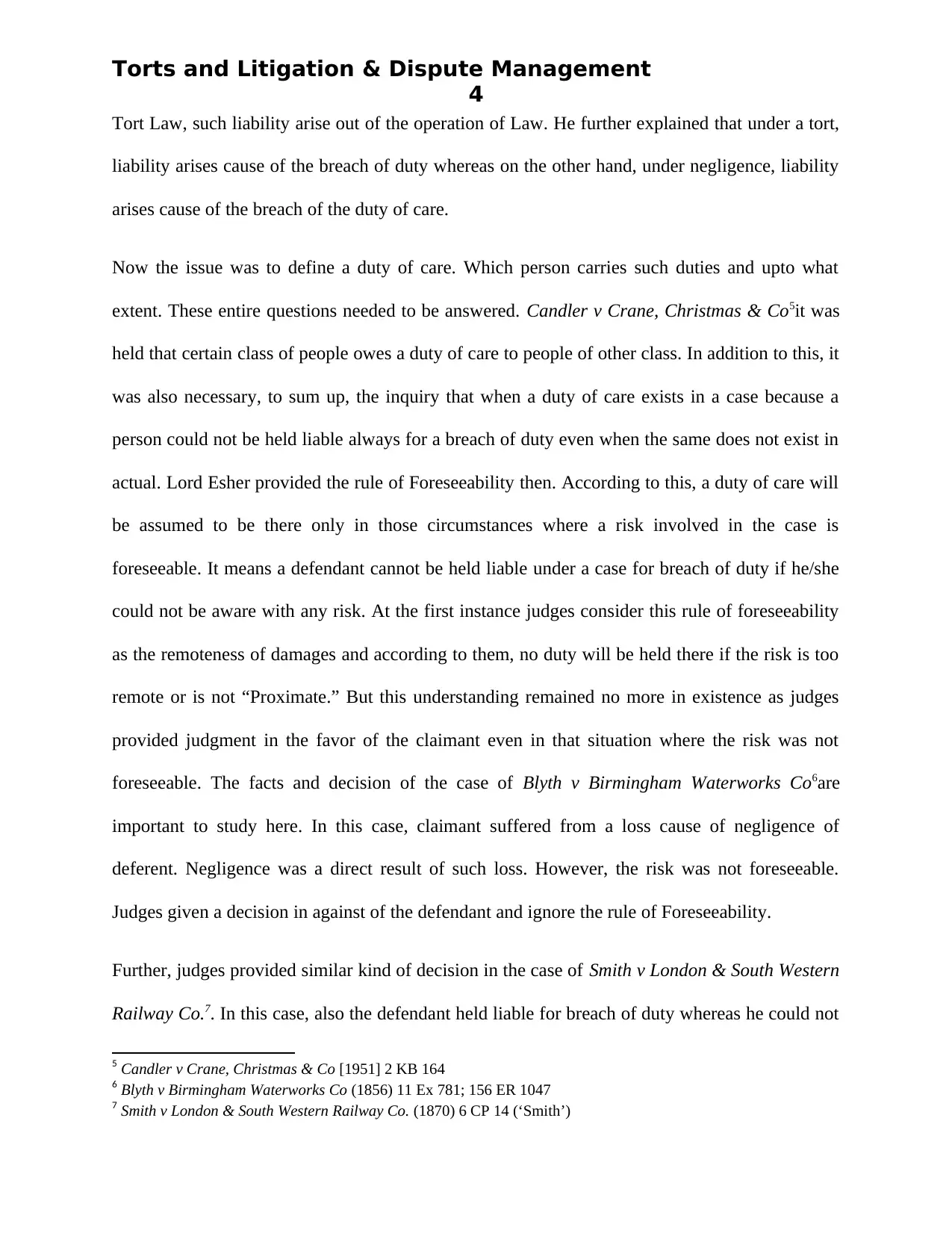
Torts and Litigation & Dispute Management
4
Tort Law, such liability arise out of the operation of Law. He further explained that under a tort,
liability arises cause of the breach of duty whereas on the other hand, under negligence, liability
arises cause of the breach of the duty of care.
Now the issue was to define a duty of care. Which person carries such duties and upto what
extent. These entire questions needed to be answered. Candler v Crane, Christmas & Co5it was
held that certain class of people owes a duty of care to people of other class. In addition to this, it
was also necessary, to sum up, the inquiry that when a duty of care exists in a case because a
person could not be held liable always for a breach of duty even when the same does not exist in
actual. Lord Esher provided the rule of Foreseeability then. According to this, a duty of care will
be assumed to be there only in those circumstances where a risk involved in the case is
foreseeable. It means a defendant cannot be held liable under a case for breach of duty if he/she
could not be aware with any risk. At the first instance judges consider this rule of foreseeability
as the remoteness of damages and according to them, no duty will be held there if the risk is too
remote or is not “Proximate.” But this understanding remained no more in existence as judges
provided judgment in the favor of the claimant even in that situation where the risk was not
foreseeable. The facts and decision of the case of Blyth v Birmingham Waterworks Co6are
important to study here. In this case, claimant suffered from a loss cause of negligence of
deferent. Negligence was a direct result of such loss. However, the risk was not foreseeable.
Judges given a decision in against of the defendant and ignore the rule of Foreseeability.
Further, judges provided similar kind of decision in the case of Smith v London & South Western
Railway Co.7. In this case, also the defendant held liable for breach of duty whereas he could not
5 Candler v Crane, Christmas & Co [1951] 2 KB 164
6 Blyth v Birmingham Waterworks Co (1856) 11 Ex 781; 156 ER 1047
7 Smith v London & South Western Railway Co. (1870) 6 CP 14 (‘Smith’)
4
Tort Law, such liability arise out of the operation of Law. He further explained that under a tort,
liability arises cause of the breach of duty whereas on the other hand, under negligence, liability
arises cause of the breach of the duty of care.
Now the issue was to define a duty of care. Which person carries such duties and upto what
extent. These entire questions needed to be answered. Candler v Crane, Christmas & Co5it was
held that certain class of people owes a duty of care to people of other class. In addition to this, it
was also necessary, to sum up, the inquiry that when a duty of care exists in a case because a
person could not be held liable always for a breach of duty even when the same does not exist in
actual. Lord Esher provided the rule of Foreseeability then. According to this, a duty of care will
be assumed to be there only in those circumstances where a risk involved in the case is
foreseeable. It means a defendant cannot be held liable under a case for breach of duty if he/she
could not be aware with any risk. At the first instance judges consider this rule of foreseeability
as the remoteness of damages and according to them, no duty will be held there if the risk is too
remote or is not “Proximate.” But this understanding remained no more in existence as judges
provided judgment in the favor of the claimant even in that situation where the risk was not
foreseeable. The facts and decision of the case of Blyth v Birmingham Waterworks Co6are
important to study here. In this case, claimant suffered from a loss cause of negligence of
deferent. Negligence was a direct result of such loss. However, the risk was not foreseeable.
Judges given a decision in against of the defendant and ignore the rule of Foreseeability.
Further, judges provided similar kind of decision in the case of Smith v London & South Western
Railway Co.7. In this case, also the defendant held liable for breach of duty whereas he could not
5 Candler v Crane, Christmas & Co [1951] 2 KB 164
6 Blyth v Birmingham Waterworks Co (1856) 11 Ex 781; 156 ER 1047
7 Smith v London & South Western Railway Co. (1870) 6 CP 14 (‘Smith’)
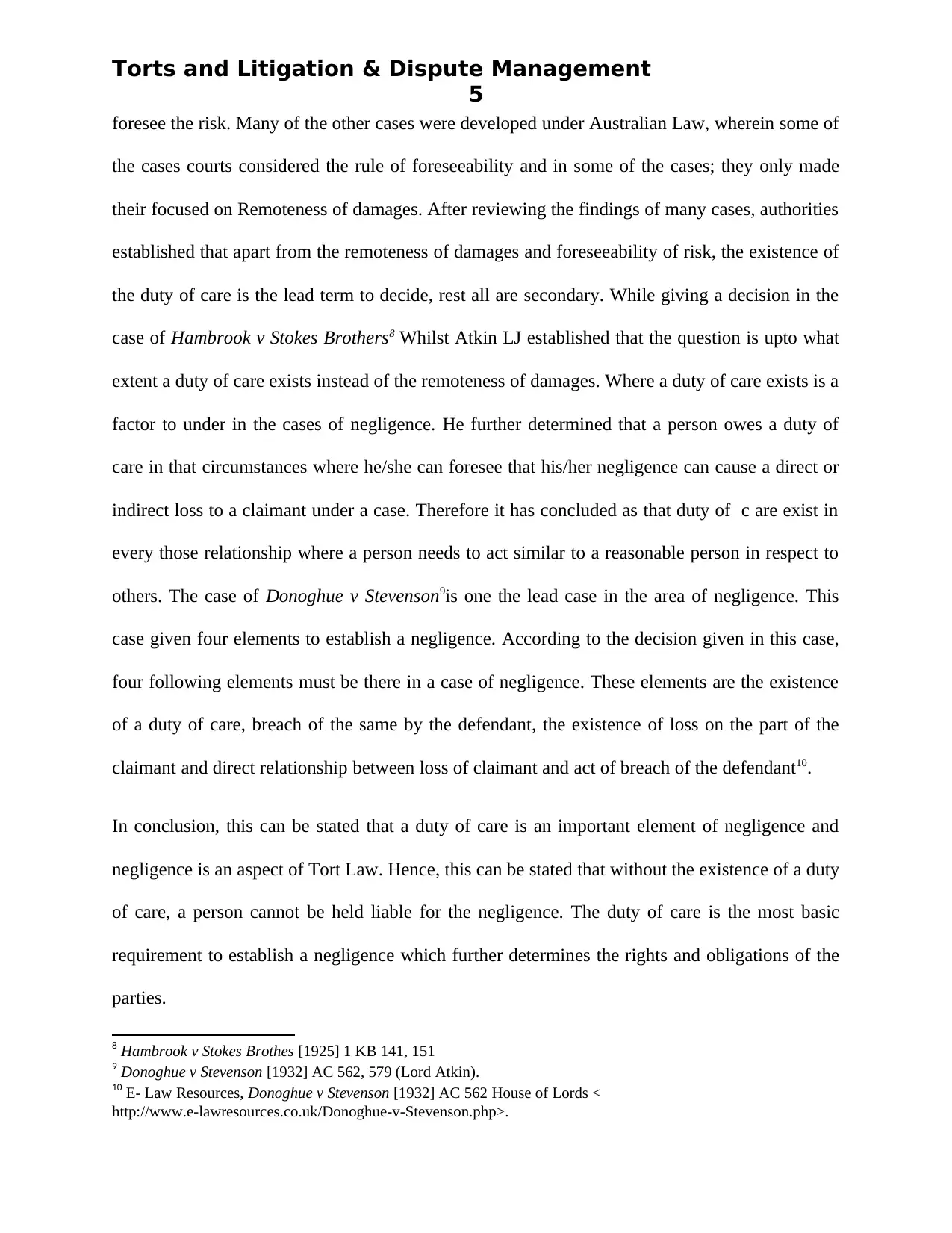
Torts and Litigation & Dispute Management
5
foresee the risk. Many of the other cases were developed under Australian Law, wherein some of
the cases courts considered the rule of foreseeability and in some of the cases; they only made
their focused on Remoteness of damages. After reviewing the findings of many cases, authorities
established that apart from the remoteness of damages and foreseeability of risk, the existence of
the duty of care is the lead term to decide, rest all are secondary. While giving a decision in the
case of Hambrook v Stokes Brothers8 Whilst Atkin LJ established that the question is upto what
extent a duty of care exists instead of the remoteness of damages. Where a duty of care exists is a
factor to under in the cases of negligence. He further determined that a person owes a duty of
care in that circumstances where he/she can foresee that his/her negligence can cause a direct or
indirect loss to a claimant under a case. Therefore it has concluded as that duty of c are exist in
every those relationship where a person needs to act similar to a reasonable person in respect to
others. The case of Donoghue v Stevenson9is one the lead case in the area of negligence. This
case given four elements to establish a negligence. According to the decision given in this case,
four following elements must be there in a case of negligence. These elements are the existence
of a duty of care, breach of the same by the defendant, the existence of loss on the part of the
claimant and direct relationship between loss of claimant and act of breach of the defendant10.
In conclusion, this can be stated that a duty of care is an important element of negligence and
negligence is an aspect of Tort Law. Hence, this can be stated that without the existence of a duty
of care, a person cannot be held liable for the negligence. The duty of care is the most basic
requirement to establish a negligence which further determines the rights and obligations of the
parties.
8 Hambrook v Stokes Brothes [1925] 1 KB 141, 151
9 Donoghue v Stevenson [1932] AC 562, 579 (Lord Atkin).
10 E- Law Resources, Donoghue v Stevenson [1932] AC 562 House of Lords <
http://www.e-lawresources.co.uk/Donoghue-v-Stevenson.php>.
5
foresee the risk. Many of the other cases were developed under Australian Law, wherein some of
the cases courts considered the rule of foreseeability and in some of the cases; they only made
their focused on Remoteness of damages. After reviewing the findings of many cases, authorities
established that apart from the remoteness of damages and foreseeability of risk, the existence of
the duty of care is the lead term to decide, rest all are secondary. While giving a decision in the
case of Hambrook v Stokes Brothers8 Whilst Atkin LJ established that the question is upto what
extent a duty of care exists instead of the remoteness of damages. Where a duty of care exists is a
factor to under in the cases of negligence. He further determined that a person owes a duty of
care in that circumstances where he/she can foresee that his/her negligence can cause a direct or
indirect loss to a claimant under a case. Therefore it has concluded as that duty of c are exist in
every those relationship where a person needs to act similar to a reasonable person in respect to
others. The case of Donoghue v Stevenson9is one the lead case in the area of negligence. This
case given four elements to establish a negligence. According to the decision given in this case,
four following elements must be there in a case of negligence. These elements are the existence
of a duty of care, breach of the same by the defendant, the existence of loss on the part of the
claimant and direct relationship between loss of claimant and act of breach of the defendant10.
In conclusion, this can be stated that a duty of care is an important element of negligence and
negligence is an aspect of Tort Law. Hence, this can be stated that without the existence of a duty
of care, a person cannot be held liable for the negligence. The duty of care is the most basic
requirement to establish a negligence which further determines the rights and obligations of the
parties.
8 Hambrook v Stokes Brothes [1925] 1 KB 141, 151
9 Donoghue v Stevenson [1932] AC 562, 579 (Lord Atkin).
10 E- Law Resources, Donoghue v Stevenson [1932] AC 562 House of Lords <
http://www.e-lawresources.co.uk/Donoghue-v-Stevenson.php>.
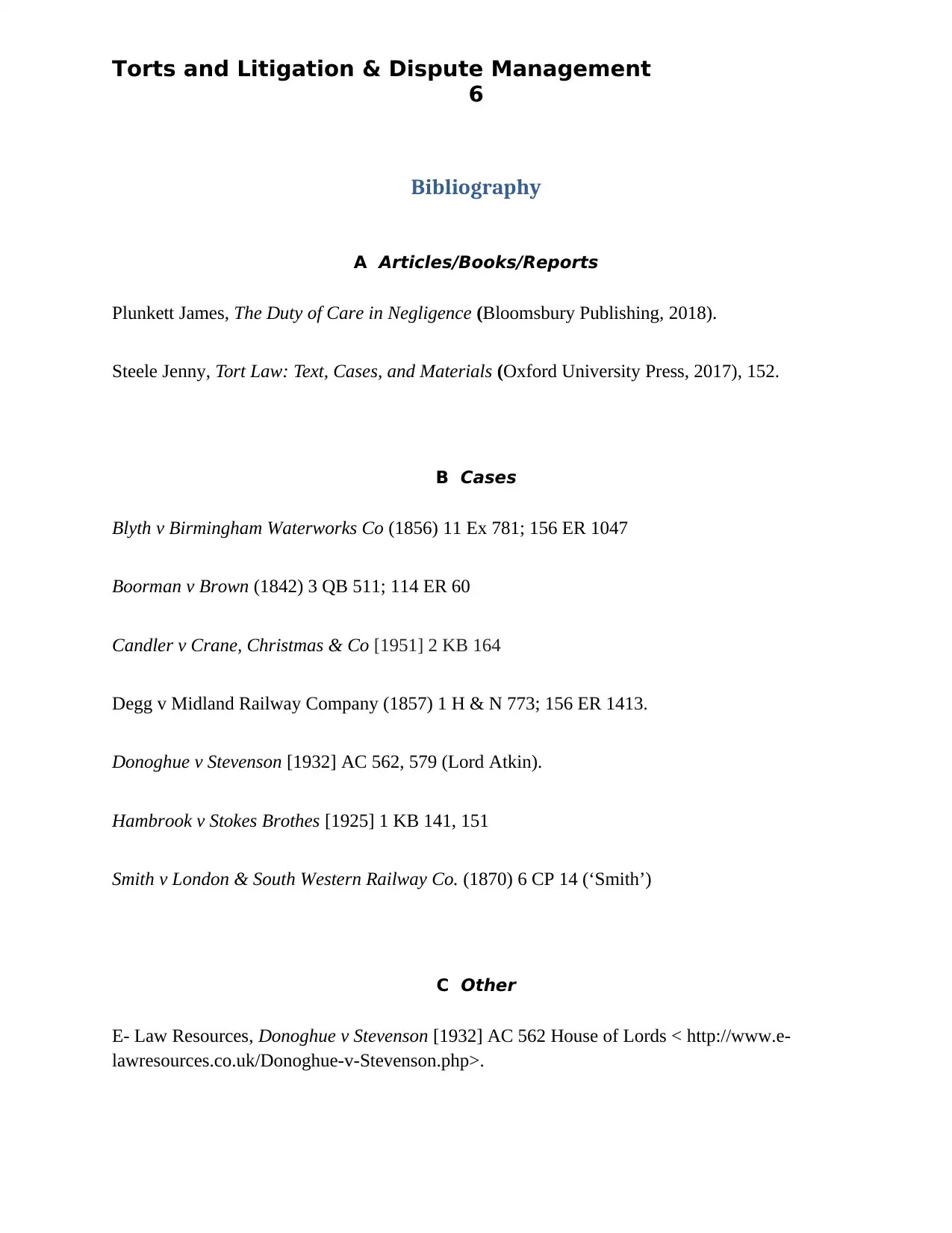
Torts and Litigation & Dispute Management
6
Bibliography
A Articles/Books/Reports
Plunkett James, The Duty of Care in Negligence (Bloomsbury Publishing, 2018).
Steele Jenny, Tort Law: Text, Cases, and Materials (Oxford University Press, 2017), 152.
B Cases
Blyth v Birmingham Waterworks Co (1856) 11 Ex 781; 156 ER 1047
Boorman v Brown (1842) 3 QB 511; 114 ER 60
Candler v Crane, Christmas & Co [1951] 2 KB 164
Degg v Midland Railway Company (1857) 1 H & N 773; 156 ER 1413.
Donoghue v Stevenson [1932] AC 562, 579 (Lord Atkin).
Hambrook v Stokes Brothes [1925] 1 KB 141, 151
Smith v London & South Western Railway Co. (1870) 6 CP 14 (‘Smith’)
C Other
E- Law Resources, Donoghue v Stevenson [1932] AC 562 House of Lords < http://www.e-
lawresources.co.uk/Donoghue-v-Stevenson.php>.
6
Bibliography
A Articles/Books/Reports
Plunkett James, The Duty of Care in Negligence (Bloomsbury Publishing, 2018).
Steele Jenny, Tort Law: Text, Cases, and Materials (Oxford University Press, 2017), 152.
B Cases
Blyth v Birmingham Waterworks Co (1856) 11 Ex 781; 156 ER 1047
Boorman v Brown (1842) 3 QB 511; 114 ER 60
Candler v Crane, Christmas & Co [1951] 2 KB 164
Degg v Midland Railway Company (1857) 1 H & N 773; 156 ER 1413.
Donoghue v Stevenson [1932] AC 562, 579 (Lord Atkin).
Hambrook v Stokes Brothes [1925] 1 KB 141, 151
Smith v London & South Western Railway Co. (1870) 6 CP 14 (‘Smith’)
C Other
E- Law Resources, Donoghue v Stevenson [1932] AC 562 House of Lords < http://www.e-
lawresources.co.uk/Donoghue-v-Stevenson.php>.
1 out of 7
Related Documents
Your All-in-One AI-Powered Toolkit for Academic Success.
+13062052269
info@desklib.com
Available 24*7 on WhatsApp / Email
![[object Object]](/_next/static/media/star-bottom.7253800d.svg)
Unlock your academic potential
© 2024 | Zucol Services PVT LTD | All rights reserved.





